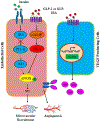GLP-1 and insulin regulation of skeletal and cardiac muscle microvascular perfusion in type 2 diabetes
- PMID: 32274893
- PMCID: PMC8393916
- DOI: 10.1111/1753-0407.13045
GLP-1 and insulin regulation of skeletal and cardiac muscle microvascular perfusion in type 2 diabetes
Abstract
Muscle microvasculature critically regulates skeletal and cardiac muscle health and function. It provides endothelial surface area for substrate exchange between the plasma compartment and the muscle interstitium. Insulin fine-tunes muscle microvascular perfusion to regulate its own action in muscle and oxygen and nutrient supplies to muscle. Specifically, insulin increases muscle microvascular perfusion, which results in increased delivery of insulin to the capillaries that bathe the muscle cells and then facilitate its own transendothelial transport to reach the muscle interstitium. In type 2 diabetes, muscle microvascular responses to insulin are blunted and there is capillary rarefaction. Both loss of capillary density and decreased insulin-mediated capillary recruitment contribute to a decreased endothelial surface area available for substrate exchange. Vasculature expresses abundant glucagon-like peptide 1 (GLP-1) receptors. GLP-1, in addition to its well-characterized glycemic actions, improves endothelial function, increases muscle microvascular perfusion, and stimulates angiogenesis. Importantly, these actions are preserved in the insulin resistant states. Thus, treatment of insulin resistant patients with GLP-1 receptor agonists may improve skeletal and cardiac muscle microvascular perfusion and increase muscle capillarization, leading to improved delivery of oxygen, nutrients, and hormones such as insulin to the myocytes. These actions of GLP-1 impact skeletal and cardiac muscle function and systems biology such as functional exercise capacity. Preclinical studies and clinical trials involving the use of GLP-1 receptor agonists have shown salutary cardiovascular effects and improved cardiovascular outcomes in type 2 diabetes mellitus. Future studies should further examine the different roles of GLP-1 in cardiac as well as skeletal muscle function.
肌肉微血管系统对骨骼肌和心肌的健康和功能起着至关重要的调节作用。它为血浆间隙和肌肉间质之间的底物交换提供内皮表面积。胰岛素微调肌肉微血管灌注, 以调节自身在肌肉中的活动, 并为肌肉提供氧气和营养。具体地说, 胰岛素增加了肌肉微血管灌注, 使得更多的胰岛素转运到毛细血管周边的肌肉细胞, 然后通过其自身的透皮转运到达肌肉间质。在2型糖尿病中, 肌肉微血管对胰岛素的反应迟钝, 毛细血管稀疏。毛细血管密度的减少和胰岛素介导的毛细血管募集的降低, 都会导致可用于底物交换的内皮表面积减少。血管系统表达丰富的胰高血糖素样肽-1(GLP-1)受体。GLP-1可以改善内皮功能, 增加肌肉微血管灌注, 并刺激血管生成。重要的是, 这些作用在胰岛素抵抗状态下得以保留。因此, 使用GLP-1受体激动剂治疗胰岛素抵抗患者, 可能会改善骨骼肌和心肌微血管灌注, 增加肌肉的毛细血管, 从而改善氧、营养物质和胰岛素等激素向心肌细胞的输送。GLP-1的这些作用影响骨骼肌和心肌功能以及生物系统, 如功能性运动能力。涉及使用GLP-1受体激动剂的临床前研究和临床试验已经显示了有益的心血管效应, 并改善了2型糖尿病的心血管结局。未来的研究应该进一步研究GLP-1在心肌和骨骼肌功能中的不同作用.
Keywords: GLP-1; cardiac muscle; endothelium; insulin resistance; microvascular perfusion; skeletal muscle; 内皮; 微血管灌注; 心肌; 胰岛素抵抗; 骨骼肌.
© 2020 Ruijin Hospital, Shanghai Jiaotong University School of Medicine and John Wiley & Sons Australia, Ltd.
Figures




Similar articles
-
Liraglutide prevents microvascular insulin resistance and preserves muscle capillary density in high-fat diet-fed rats.Am J Physiol Endocrinol Metab. 2016 Sep 1;311(3):E640-8. doi: 10.1152/ajpendo.00205.2016. Epub 2016 Jul 19. Am J Physiol Endocrinol Metab. 2016. PMID: 27436611 Free PMC article.
-
Vasodilatory Actions of Glucagon-Like Peptide 1 Are Preserved in Skeletal and Cardiac Muscle Microvasculature but Not in Conduit Artery in Obese Humans With Vascular Insulin Resistance.Diabetes Care. 2020 Mar;43(3):634-642. doi: 10.2337/dc19-1465. Epub 2019 Dec 30. Diabetes Care. 2020. PMID: 31888883 Free PMC article. Clinical Trial.
-
GLP-1 at physiological concentrations recruits skeletal and cardiac muscle microvasculature in healthy humans.Clin Sci (Lond). 2014 Aug;127(3):163-70. doi: 10.1042/CS20130708. Clin Sci (Lond). 2014. PMID: 24552454 Free PMC article.
-
Glucagon-like peptide-1 receptor action in the vasculature.Peptides. 2019 Jan;111:26-32. doi: 10.1016/j.peptides.2018.09.002. Epub 2018 Sep 15. Peptides. 2019. PMID: 30227157 Review.
-
Physiological mechanisms of action of incretin and insulin in regulating skeletal muscle metabolism.Curr Diabetes Rev. 2014;10(5):327-35. doi: 10.2174/1573399810666141017153749. Curr Diabetes Rev. 2014. PMID: 25323297 Review.
Cited by
-
The cardiovascular changes underlying a low cardiac output with exercise in patients with type 2 diabetes mellitus.Front Physiol. 2024 Mar 20;15:1294369. doi: 10.3389/fphys.2024.1294369. eCollection 2024. Front Physiol. 2024. PMID: 38571722 Free PMC article. Review.
-
Sarcopenia and Diabetes: A Detrimental Liaison of Advancing Age.Nutrients. 2023 Dec 25;16(1):63. doi: 10.3390/nu16010063. Nutrients. 2023. PMID: 38201893 Free PMC article. Review.
-
Liraglutide Accelerates Ischemia-Induced Angiogenesis in a Murine Diabetic Model.J Am Heart Assoc. 2023 Feb 21;12(4):e026586. doi: 10.1161/JAHA.122.026586. Epub 2023 Feb 15. J Am Heart Assoc. 2023. PMID: 36789853 Free PMC article.
-
Interplay of fatty acids, insulin and exercise in vascular health.Lipids Health Dis. 2025 Jan 7;24(1):4. doi: 10.1186/s12944-024-02421-5. Lipids Health Dis. 2025. PMID: 39773723 Free PMC article. Review.
-
AKG/OXGR1 promotes skeletal muscle blood flow and metabolism by relaxing vascular smooth muscle.Life Metab. 2022 Sep 29;1(3):285-297. doi: 10.1093/lifemeta/loac026. eCollection 2022 Dec. Life Metab. 2022. PMID: 39872069 Free PMC article.
References
-
- Ferrannini E, Simonson DC, Katz LD, et al.The disposal of an oral glucose load in patients with non-insulin-dependent diabetes. Metabolism. 1988;37:79–85. - PubMed
-
- Honig CR, Odoroff CL, Frierson JL. Active and passive capillary control in red muscle at rest and in exercise. Am J Physiol. 1982;243:H196–H206. - PubMed
Publication types
MeSH terms
Substances
Grants and funding
LinkOut - more resources
Full Text Sources
Other Literature Sources
Medical

